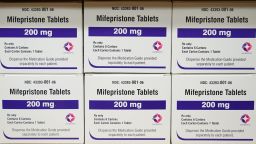Less than a year after the US Supreme Court ended legal protection for abortions nationwide, clinics that provide reproductive health care across the United States are bracing for more restrictions on the care they provide to women.
If a judge’s ruling takes effect Friday, it may soon be illegal for doctors to prescribe mifepristone, the first in a two-drug regimen that can help women terminate a pregnancy at home – and that has other uses.
At Northeast Ohio Women’s Center, staffers are calling patients who expected to get medication abortions next week, telling them to change their plans.
“They’re scrambling to change their schedules to get in to see us earlier,” said Dr. David Burkons, the physician who runs the clinics.
About half of abortions in the US use mifepristone, which is sold under the brand name Mifeprex.
Mifeprex blocks the hormone progesterone, which effectively stops a pregnancy from continuing. For an abortion, women take mifepristone first, followed one or two days later by misoprostol, a drug that causes the uterus to contract, cramp and bleed, similar to a heavy period. It empties out the uterus, ending the pregnancy. It can be used up to 10 weeks of pregnancy.
But the uses of mifepristone go beyond abortion.
The drug helps soften and open the cervix, the neck of the uterus, and doctors depend on it to help when women are having a miscarriage and when a pregnancy needs to be terminated quickly if the life of the mother is at stake.
In certain situations, when a pregnancy has become too risky, time is of the essence, says Dr. Alison Edelman, who directs the division of Complex Family Planning at Oregon Health and Sciences University.
“The more expediently that we can have somebody not be pregnant, the better, and mifepristone helps us speed that process up and make it safer for patients,” she said.
Doctors also use mifepristone before procedures in which they need to go into the uterus, such as to remove bleeding polyps. Studies have shown that the drug helps reduce the amount of force needed to open the cervix and reduces the amount of blood loss associated with the procedure.
Studies also show that mifepristone has moderate to strong benefits for inducing labor and treating uterine fibroids and endometriosis, sometimes helping avoid surgery, according to the American Society of Health Systems Pharmacists.
It can be used to prevent bleeding between periods and to control hyperstimulation of the ovaries during in-vitro fertilization, the society said in a statement.
Doctors say they still have other ways to treat those problems, but when considering the needs of individual patients, they will be missing a valuable tool.
“We have our gold standard of what we provide – the safest, most effective regimen – and then if it’s not available, we use the next best one. And that’s what we would be left with,” Edelman said.
Mifepristone has been approved by the US Food and Drug Administration for 23 years, and it has been used by over 5 million women in the United States. FDA data shows that less than 1% of women who take it have significant adverse events. A CNN analysis of FDA data found that mifepristone was even less risky than some other common medications, including Viagra and penicillin.
Medication abortions have become an increasingly important option for women in states that restricted abortion access after the Supreme Court’s ruling last year that ended legal protections for abortions in every state. They are also sometimes the only kind of abortion many women can get in rural areas that have lost abortion providers.
This ease of access has also made the medication regimen a target for abortion opponents.
“They want to see a national ban, and this is in fact what they are going for in this case,” said Kristen Moore, director of the EMAA Project, a nonprofit that is seeking to make it easier to get abortion medications in the US.
What will happen next is far from settled. Appeals have been filed to stop the ruling in Texas from taking hold, and higher courts will have to weigh in.
Even if the court does take mifepristone off the market in the US, doctors say, they will still be able to provide medication abortions using misoprostol alone.
In fact, some abortion providers have been planning on using misoprostol by itself in case mifepristone is isn’t available.
Carafem, which provides telehealth abortion care, has been offering a misoprostol-only regimen since the Covid-19 pandemic began, Chief Operating Officer Melissa Grant says.
“In 2020, we started to use misoprostol alone as an option,” she said. Workers have since been tweaking the regimen and gathering data.
“We now feel confident that, even though we would much prefer to use both, that we can use misoprostol alone effectively and are ready to switch gears to have a higher percentage of our clients or even 100% of our colleagues use that option if necessary,” Grant said.
Still, some providers said it’s not ideal.
The misoprostol-only regimen is slightly less effective than the one that uses both drugs, and it causes more cramping and bleeding, which can mean more complications.
Get CNN Health's weekly newsletter
- Sign up here to get The Results Are In with Dr. Sanjay Gupta every Friday from the CNN Health team.
“We’re more likely to see failures and therefore more likely to need surgical intervention after misoprostol alone,” said Dr. Erika Werner, chair of the Department of Obstetrics and Gynecology at Tufts Medical Center.
Still, doctors want women to know that medication abortions and miscarriage care will still be available even if mifepristone isn’t. And they hope that higher courts will intervene to keep this medication on pharmacy shelves.
“The clinicians would have to use these other options instead of choosing based on their own expertise, knowledge and judgment when rendering such care,” Dr. Iffath Hoskins, president of the American Congress of Obstetricians and Gynecologists, said Monday. “Frankly, as a clinician, I do not want to be in that position.”
CNN’s Elizabeth Cohen and Amanda Sealy contributed to this report.
Correction: This story has been updated to include the correct name of Tufts Medical Center.






